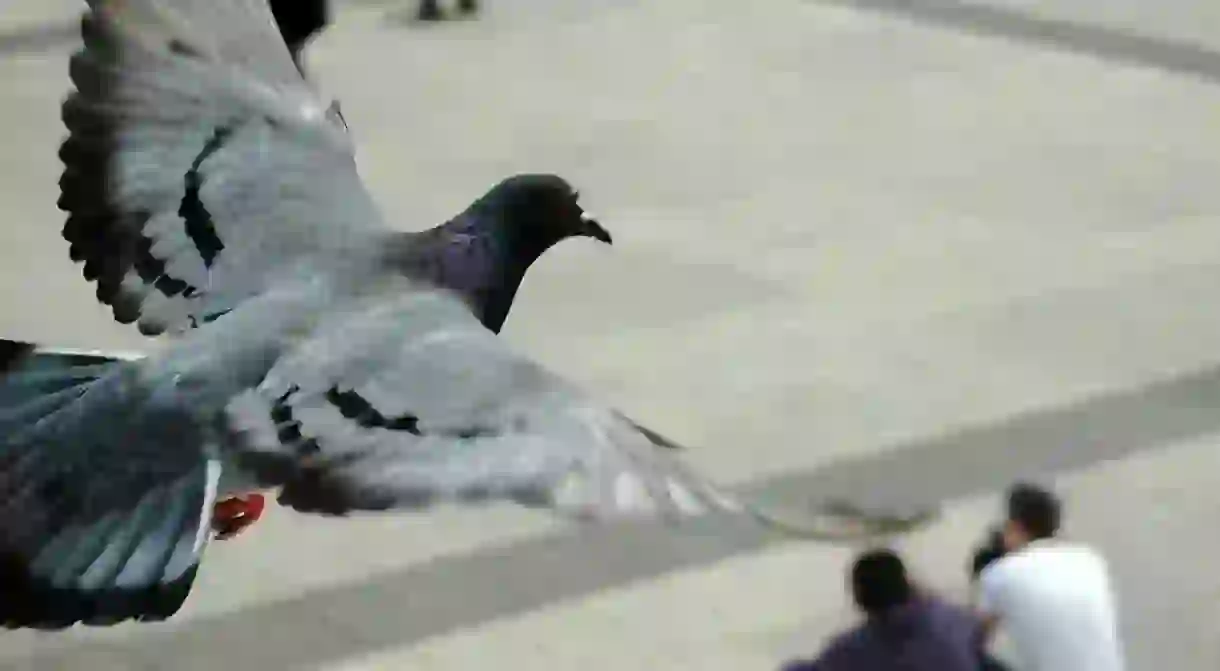The Pigeons of Paris: from Post to Pest

We’ve all been the person whose single misstep in a crowded square inexplicably triggers an explosion of feathers, dust, and flapping hands. When the literal definition of birdbrained decision-making is flying at your face, it can seem like there must be a billion pigeons in Paris. Actually, there are just 80,000 – roughly one for every 25 human Parisians – but even this number can wreak havoc. But how did they even get here?
The glory days of the Paris pigeon
Unlike people, if pigeons are ripped from their beds, stuffed into a cage, driven out into the middle of nowhere, and abandoned by the roadside, they are able, without a great deal of difficulty and zero technology, to find their way back home. This innate skill makes them ideal candidates for a job in the postal service.

For Paris, the pigeon’s shining moment came during the Franco-Prussian War of 1870 to 1871. On September 2nd, just six weeks into hostilities, Emperor Napoleon III surrendered at Sedan. At once, the Second Empire toppled and its capital city was surrounded by Prussian forces.
For the four-and-a-half months of the siege, all normal channels of communications were cut off. In its first weeks, a few exceedingly brave postmen managed to slip through enemy lines. Many more were captured and killed. By October, all attempts had stopped. From that point on, the only way to get a message into Paris was by using a carrier pigeon.

The birds were first escorted out of Paris in a hot air balloon by someone willing to leave for good. Once the balloon landed, a single bird was released. Its return to its city dovecote, announced by a ringing bell, would signal that the rest had gotten out alive.
The pigeons were then secretly transported to one of two bases in Tours and Poitiers. There, they rested, preened, and filled up on grain in readiness for the homeward journey. As the cities are 200km and 300km away, respectively, the birds were taken by train as close to Paris as was thought safe. At the last moment, they were loaded with their dispatches and released. The first message, dated September 27th, reached Paris on October 1st.
But the Prussians weren’t stupid. Cottoning on to the Parisians’ creative postal service, soldiers were ordered to fire at any pigeons they saw overhead and falconers were drafted into the army.
Luckily, Parisians had a few more tricks up their sleeves. The same message was attached to as many as 35 birds and these were released in groups on different days, increasing the likelihood of one bird and its cargo making it past the onslaught of bullets and birds of prey.

When René Dagron, a talented photographer, figured out how to condense hundreds of documents onto one tiny roll of microfilm, the potential of the pigeon post expanded almost exponentially.
By the time the siege was over and the service terminated on February 1st, 1871, more than a million messages had been successful delivered. The pigeons were then auctioned off as property of the state, fetching an average price of one franc and 50 centimes.
The success of the mission was noted by powers across Europe and, soon, every army on the continent had its own pigeon section.
The crappy days of the Paris pigeon
Many of the pigeons in Paris today, the ones being chased by children and kicked at by mean-spirited adults, are the distant descendants of these heroic 19th-century birds, or at least of those who were wily enough to escape from captivity.

While they aren’t being shot at by Prussian soldiers or being hunted down by super-speedy peregrine falcons (yet), they aren’t exactly being shown the love by French authorities. Under French law, it is illegal to feed pigeons in Paris. Doing so could land you with a 450€ (US$481) fine.
Undeterred, a subculture of nighttime bird feeders has emerged in recent years. Of all the things you can get caught doing by the police in a park after dark, sprinkling bread crumbs under a tree full of pigeons has to be the most bizarre. Still, each to their own!
There are several legitimate reasons why people are getting annoyed at these nourrisseurs (and, presumably, nourrisseuses). Feeding leads to overcrowding which in turn causes increased competition, aggression, and disease. These midnight feasts will also be messing with the birds’ biological clocks.

More pigeons also means more pigeon poo.
This matter of faecal importance has recently been affecting a subdivision of the Paris police. A union of the STJA (service du traitement judiciaire des accidents), which deals with fatal or serious accidents on Paris’ roads, has officially complained to the Préfecture de Police about the damage pigeons are doing to its vans.
Apparently, they have taken up residence in the trees that line the service’s parking lot and, on a nightly basis, are dropping a hot mess onto the windscreens. There have been reports of members of the public pointing, laughing, and taking photographs of officers scrubbing them clean.
Understandably, the men and women of the STJA are worried about becoming the butt of every joke.
What does the future hold?
One step being taken to reduce the number of pigeons in Paris is a rather unusual form of contraception.

Special pigeon houses have been installed around the city since as far back as 2003. The birds are attracted to these sites by regular feedings (ironic, no?) and are all too keen to make their nests in the boxes provided.
The birds are allowed to rear one brood of chicks a year but all subsequent clutches of eggs are shaken and the embryos inside destroyed.
Stifling the pigeons’ natural fertility is, so far, the best defense against a population boom.













